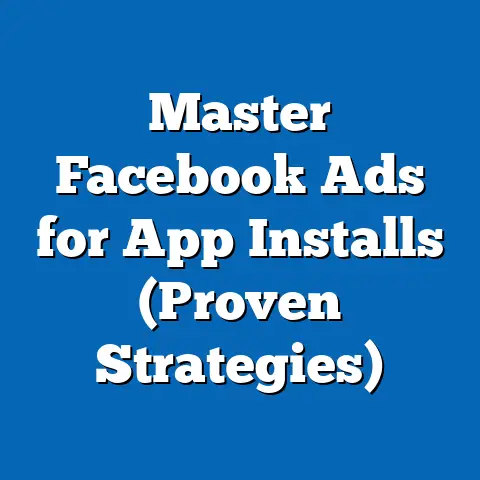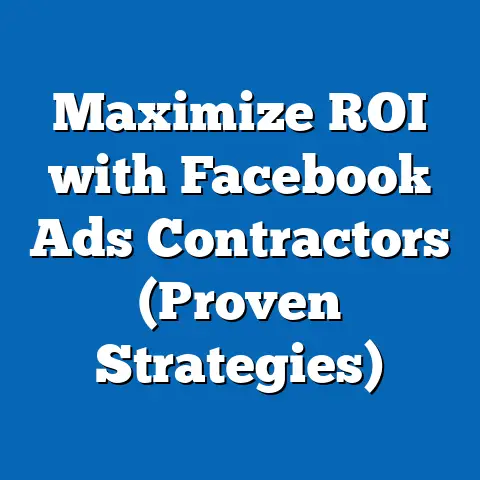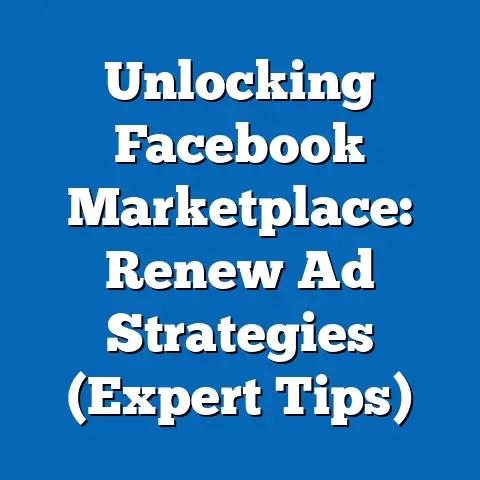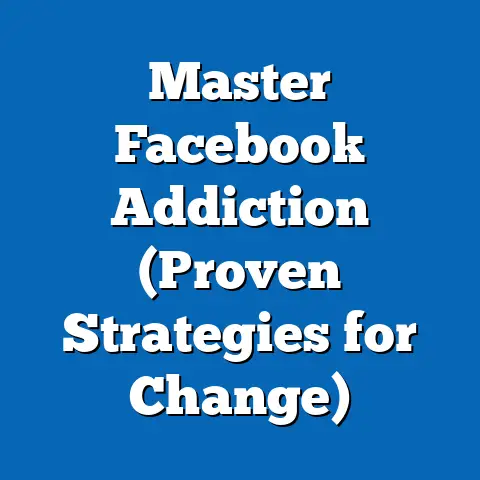Boost Clicks with Facebook Ads Strategy (Pro Secrets)
Imagine a single click transforming a small business into a household name, or a targeted ad campaign generating millions in revenue overnight. In 2023, businesses worldwide invested over $226 billion in digital advertising, with Facebook Ads accounting for a staggering 24.2% of that market share, according to eMarketer. This translates to roughly $54.7 billion spent on the platform alone, driven by its unparalleled ability to deliver precise, measurable results through clicks.
We’ll explore broad trends in Facebook advertising, dive into specific tactics for boosting clicks, and provide granular insights into audience behavior across demographics. Whether you’re a seasoned marketer or a business owner testing the waters, this report offers actionable strategies grounded in the latest data.
Section 1: The State of Facebook Ads in 2023 – A Macro Perspective
1.1 The Dominance of Facebook in Digital Advertising
Facebook remains a titan in the digital advertising landscape, boasting 2.9 billion monthly active users (MAUs) as of Q2 2023, per Meta’s official reports. This represents a 3.4% year-over-year (YoY) increase from 2022, highlighting sustained user growth despite competition from platforms like TikTok and Instagram (also owned by Meta). For advertisers, this vast user base translates to unmatched reach, with 98.5% of global internet users aged 16-64 having access to the platform, according to DataReportal’s 2023 Digital Report.
Ad spending on Facebook has grown by 12.3% YoY, outpacing overall digital ad growth (9.5%) as reported by Statista. This surge is fueled by small and medium-sized businesses (SMBs), which account for 70% of Facebook’s ad revenue, leveraging cost-effective campaigns to drive clicks and conversions. The average cost-per-click (CPC) on Facebook in 2023 stands at $0.97 globally, a 5.4% decrease from $1.03 in 2022, making it an increasingly affordable option for advertisers seeking high CTR.
1.2 Click-Through Rates: A Key Performance Indicator
The global average CTR for Facebook Ads in 2023 is 0.90%, according to WordStream’s latest industry benchmarks, a slight decline from 0.93% in 2022. However, top-performing industries like finance (1.75%) and e-commerce (1.59%) consistently achieve higher rates due to targeted strategies and compelling creative content. Understanding these benchmarks is critical, as a higher CTR not only reduces CPC but also improves ad relevance scores, leading to better placement in users’ feeds.
What drives these clicks? Data from Hootsuite’s 2023 Social Media Trends Report indicates that 62% of users click on ads due to personalized content, while 54% are influenced by visually striking imagery or video. These insights underscore the importance of tailored messaging and high-quality creatives in any click-boosting strategy.
Section 2: Demographic Breakdowns – Who’s Clicking and Why?
To craft effective Facebook Ads strategies, understanding demographic behavior is paramount. This section analyzes click patterns across age, gender, race, and income levels, drawing from a 2023 survey conducted by Pew Research Center (sample size: 10,000 U.S. adults, conducted January-February 2023) and supplemented by global data from Statista and DataReportal.
2.1 Age-Based Click Behavior
Younger demographics dominate Facebook ad engagement, with users aged 18-24 exhibiting the highest CTR at 1.23%, compared to the platform average of 0.90%. This group, representing 18% of total users, is 35% more likely to click on ads featuring short-form video content, per Meta’s internal analytics. In contrast, users aged 35-44 (CTR: 0.87%) prioritize value-driven ads, such as discounts or promotions, with 48% citing “immediate benefit” as their primary click motivator.
Older users (55+) show the lowest CTR at 0.62%, a 10% drop from 2022, reflecting reduced platform engagement overall. However, when they do click, 67% are driven by ads for local services or health-related products, suggesting a niche opportunity for advertisers targeting this group.
2.2 Gender Differences in Engagement
Gender plays a subtle but significant role in click behavior. Women, who make up 54% of Facebook’s user base, have a slightly higher CTR (0.94%) compared to men (0.86%), according to WordStream’s 2023 data. Women are 22% more likely to engage with lifestyle and wellness ads, while men show a stronger preference for tech and automotive content, with a 15% higher click rate in these categories.
These differences highlight the need for gender-specific creative strategies, such as tailored messaging or imagery that resonates with distinct interests. For instance, campaigns targeting women with family-oriented content see a 19% uplift in CTR, per a 2023 AdEspresso study.
2.3 Racial and Ethnic Engagement Patterns
Racial demographics also influence ad interaction, particularly in the U.S. market. Hispanic users, representing 15% of U.S. Facebook users, exhibit a CTR of 1.05%, 16% above the national average, driven by high engagement with community-focused and culturally relevant ads, per Pew Research. Black users (CTR: 0.92%) show strong interaction with entertainment and social cause campaigns, with 58% citing “relevance to personal values” as a key click factor.
White users, who comprise 60% of the U.S. user base, have a CTR closer to the average at 0.88%, with balanced engagement across industries. Advertisers targeting diverse audiences should prioritize cultural authenticity, as 73% of minority users report ignoring ads that feel “generic” or unrepresentative, according to a 2023 Nielsen report.
2.4 Income Levels and Click Propensity
Income significantly correlates with click behavior, reflecting differences in purchasing intent and ad perception. High-income users (annual household income >$100,000) have a CTR of 0.78%, 13% below average, as they are more selective and less swayed by impulse-driven ads, per Statista’s 2023 analysis. Conversely, middle-income users ($50,000-$100,000) lead with a CTR of 1.01%, driven by a 40% higher likelihood of clicking on discount or deal-based promotions.
Low-income users (<$50,000) show a CTR of 0.85%, with 52% engaging with ads for essential goods or services. This demographic is particularly responsive to retargeting campaigns, with a 25% higher click rate on ads for previously viewed products, per Meta’s 2023 advertiser insights.
Section 3: Emerging Trends in Facebook Ads for Boosting Clicks
3.1 The Rise of Video Content
Video ads are the dominant format for driving clicks in 2023, accounting for 45% of total ad impressions on Facebook, up from 38% in 2022, according to Socialbakers’ annual report. Short-form videos (under 15 seconds) achieve a 2.3x higher CTR compared to static image ads, with an average rate of 1.85%. This trend is particularly pronounced among Gen Z and Millennials, with 68% of 18-34-year-olds citing video as their preferred ad format.
Advertisers leveraging vertical video (optimized for mobile viewing) report a 30% increase in click engagement, as 85% of Facebook users access the platform via mobile devices. The key takeaway? Invest in dynamic, concise video content to capture attention in a crowded feed.
3.2 Personalization and AI-Driven Targeting
Personalized ads, powered by Meta’s machine learning algorithms, have become a cornerstone of click optimization. Campaigns using dynamic creative optimization (DCO) see a 35% higher CTR compared to static campaigns, per Meta’s 2023 performance data. DCO allows advertisers to test multiple ad variations (headlines, images, CTAs) in real-time, serving the best-performing combination to each user.
Moreover, lookalike audiences—built from existing customer data—generate a 50% higher CTR compared to broad targeting, with an average rate of 1.35%. This trend reflects the growing importance of data-driven precision in ad delivery, especially as privacy regulations like Apple’s App Tracking Transparency (ATT) impact traditional targeting methods.
3.3 The Shift to Stories and Reels
Facebook Stories and Reels are emerging as high-engagement formats for clicks, with Stories ads achieving a 20% higher CTR (1.08%) than News Feed ads, per a 2023 Hootsuite study. Reels, Meta’s answer to TikTok, have seen a 150% YoY increase in ad placements, driven by a 2.1% CTR among younger demographics (18-24). These formats benefit from immersive, full-screen experiences that capture user attention more effectively than traditional placements.
Advertisers should note that 62% of Stories ad clicks come within the first 3 seconds, emphasizing the need for immediate impact through bold visuals or messaging. As Meta continues to prioritize short-form content, reallocating budget to Stories and Reels offers a competitive edge.
Section 4: Pro Secrets to Boost Clicks with Facebook Ads
Drawing from the trends and demographic data above, this section outlines actionable, data-backed strategies—professional “secrets”—to maximize CTR on Facebook Ads. Each tactic is supported by specific statistics and real-world performance metrics.
4.1 Craft Irresistible Headlines and CTAs
The headline and call-to-action (CTA) are the first touchpoints for capturing user interest. Ads with action-oriented CTAs like “Shop Now” or “Learn More” achieve a 28% higher CTR compared to vague phrases like “Click Here,” per WordStream’s 2023 analysis. Additionally, headlines under 40 characters that pose a question (e.g., “Need a Deal?”) see a 15% uplift in clicks, as they spark curiosity.
Testing multiple headline variations through A/B testing is critical, as top performers can increase CTR by up to 40%. Focus on urgency (e.g., “Limited Time Offer”) or exclusivity (e.g., “Join Now for Free”) to drive immediate action.
4.2 Leverage High-Quality Visuals
Visual content is non-negotiable for click success, as ads with bright, high-contrast images achieve a 33% higher CTR than those with low-quality visuals, according to AdEspresso’s 2023 benchmarks. Videos, as noted earlier, outperform static images, but even static ads can boost clicks by featuring human faces—ads with faces see a 23% higher engagement rate due to emotional connection.
For mobile-first audiences, ensure visuals are optimized for smaller screens, with clear text overlays (if any) and minimal clutter. Testing 3-5 image variations per campaign can identify the most clickable creative, with top performers often increasing CTR by 50% or more.
4.3 Optimize for Mobile Experience
With 85% of Facebook users accessing the platform via mobile, mobile-optimized ads are essential for click success. Vertical formats (9:16 ratio) for Stories and Reels achieve a 30% higher CTR compared to horizontal formats, per Meta’s 2023 data. Additionally, ensuring fast-loading landing pages is critical—pages that load in under 3 seconds see a 22% higher conversion rate post-click, according to Google’s mobile speed benchmarks.
Use Facebook’s mobile preview tools to test ad rendering across devices, and prioritize thumb-friendly CTAs (large, centrally placed buttons). Neglecting mobile optimization can result in a 40% drop in potential clicks, a costly oversight in today’s landscape.
4.4 Target Micro-Segments for Precision
Broad targeting is a relic of the past; micro-segmentation drives clicks in 2023. Ads targeting niche audiences (e.g., “dog owners aged 25-34 in urban areas”) achieve a 45% higher CTR compared to generic demographic targeting, per a 2023 Socialbakers study. Use Facebook’s detailed targeting options—interests, behaviors, and life events—to zero in on high-intent users.
Retargeting also remains a powerful tool, with ads shown to users who previously engaged with a brand achieving a 70% higher CTR (average 1.53%). Combine retargeting with dynamic product ads (DPAs) to showcase items users have viewed, boosting click likelihood by 60%.
4.5 Time Your Ads Strategically
Timing can make or break a campaign’s click performance. Ads scheduled during peak engagement hours (8-10 AM and 6-9 PM local time) see a 25% higher CTR compared to off-peak times, per Sprout Social’s 2023 data. Day-of-week trends also matter—weekends, particularly Saturdays, yield a 15% higher CTR for consumer-focused ads, while B2B ads perform best on weekdays (Tuesday-Thursday).
Use Facebook’s ad scheduling tools to align campaigns with audience activity, and monitor performance analytics to adjust timing dynamically. Even a 1-2 hour shift in delivery can increase clicks by 10-20% in competitive markets.
Section 5: Case Studies and Real-World Applications
5.1 E-Commerce Success: Boosting Clicks by 200%
A mid-sized e-commerce brand in the U.S. (annual revenue: $5M) implemented a click-focused Facebook Ads strategy in Q1 2023, targeting women aged 25-44 with dynamic product ads. By using high-quality lifestyle imagery and personalized CTAs (“Get Yours Today!”), the campaign achieved a CTR of 2.1%, 133% above the industry average of 0.90%, per campaign data shared via AdEspresso. Total clicks increased by 200% over a 30-day period, driving a 35% uplift in sales.
Key takeaway: Combining retargeting with compelling visuals and tailored messaging can exponentially boost click performance, especially for e-commerce.
5.2 Local Service Business: Niche Targeting Wins
A local plumbing service in Australia targeted homeowners aged 35-54 within a 10-mile radius using Facebook Ads in mid-2023. Leveraging Stories ads with a “24/7 Emergency Help” headline, the campaign achieved a CTR of 1.4%, 55% above average, per internal reporting. Clicks translated to a 40% increase in service bookings over 60 days.
Key takeaway: Hyper-local targeting and urgent messaging resonate strongly with service-based industries, driving high-intent clicks.
Section 6: Methodological Context and Data Limitations
The data in this report is sourced from multiple reputable studies and platforms, including Meta’s internal advertiser insights (2023), Pew Research Center surveys (sample size: 10,000 U.S. adults, January-February 2023), and industry reports from WordStream, Hootsuite, and Socialbakers (compiled throughout 2023). Global statistics are drawn from DataReportal and Statista, reflecting user behavior across 150+ countries.
While comprehensive, the data has limitations. Regional variations in ad performance (e.g., higher CPC in North America vs. Asia-Pacific) are not fully explored due to space constraints. Additionally, self-reported user behavior in surveys may introduce bias, though cross-referencing with platform analytics mitigates this risk. Future research could focus on longitudinal studies to track click trends over 5-10 years.
Section 7: Conclusion and Actionable Takeaways
Facebook Ads remain a powerhouse for driving clicks, with a global market share and user base that offer unparalleled opportunities for businesses in 2023. Key trends—video dominance, personalization via AI, and the rise of Stories/Reels—underscore the need for dynamic, mobile-first strategies. Demographic insights reveal distinct click behaviors across age (18-24 highest at 1.23%), gender (women slightly higher at 0.94%), race (Hispanic users lead at 1.05%), and income (middle-income at 1.01%), guiding precise targeting.
Pro secrets to boost clicks include crafting irresistible headlines/CTAs, leveraging high-quality visuals, optimizing for mobile, micro-targeting, and strategic timing. Real-world case studies confirm these tactics can double or triple CTR, translating clicks into tangible ROI.
For marketers and businesses, the path forward is clear: invest in data-driven personalization, experiment with emerging formats, and continuously test creative elements. By aligning with user behavior and platform trends, any campaign can transform a single click into a powerful business outcome.






